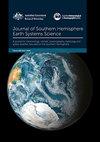Characterising the seasonal nature of meteorological drought onset and termination across Australia
IF 3.6
4区 地球科学
Q1 Earth and Planetary Sciences
引用次数: 1
Abstract
Drought, and its associated impacts, represents one of the costliest natural hazards worldwide, highlighting the need for prediction and preparedness. While advancements have been made in monitoring current droughts, prediction of onset and termination have proven to be much more challenging. This is because drought is unlike any other natural hazard and cannot be characterised by a single weather event. There is also a high degree of spatial variability in this phenomenon across the vast expanse of the Australian continent. Therefore, by characterising regionally specific expressions of drought, we may improve drought predictability. In this study, we analyse the timing of onset and termination of meteorological droughts across Australia from 1900 to 2015, as well as their local and regional climate controls. We show that meteorological drought onset has a strong seasonal signature across Australia that varies spatially, whereas termination is less seasonally restricted. Using a Random Forest modelling approach with predictor variables representative of large-scale ocean-atmosphere phenomena and local climate, up to 75% of the variance in the Standardised Precipitation Index during both onset and termination could be explained. This study offers support to continued development in long-lead forecasting of local and large-scale ocean/atmosphere conditions to improve drought prediction in Australia and elsewhere.描述了澳大利亚各地气象干旱发生和终止的季节性特征
本文章由计算机程序翻译,如有差异,请以英文原文为准。
求助全文
约1分钟内获得全文
求助全文
来源期刊

Journal of Southern Hemisphere Earth Systems Science
Earth and Planetary Sciences-Oceanography
CiteScore
8.10
自引率
8.30%
发文量
0
审稿时长
>12 weeks
期刊介绍:
The Journal of Southern Hemisphere Earth Systems Science (JSHESS) publishes broad areas of research with a distinct emphasis on the Southern Hemisphere. The scope of the Journal encompasses the study of the mean state, variability and change of the atmosphere, oceans, and land surface, including the cryosphere, from hemispheric to regional scales.
general circulation of the atmosphere and oceans,
climate change and variability ,
climate impacts,
climate modelling ,
past change in the climate system including palaeoclimate variability,
atmospheric dynamics,
synoptic meteorology,
mesoscale meteorology and severe weather,
tropical meteorology,
observation systems,
remote sensing of atmospheric, oceanic and land surface processes,
weather, climate and ocean prediction,
atmospheric and oceanic composition and chemistry,
physical oceanography,
air‐sea interactions,
coastal zone processes,
hydrology,
cryosphere‐atmosphere interactions,
land surface‐atmosphere interactions,
space weather, including impacts and mitigation on technology,
ionospheric, magnetospheric, auroral and space physics,
data assimilation applied to the above subject areas .
Authors are encouraged to contact the Editor for specific advice on whether the subject matter of a proposed submission is appropriate for the Journal of Southern Hemisphere Earth Systems Science.
 求助内容:
求助内容: 应助结果提醒方式:
应助结果提醒方式:


